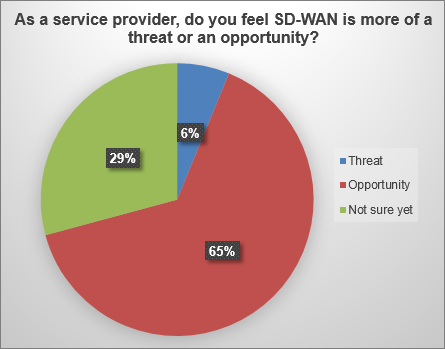SD-WAN: Threat or Opportunity?
SD-WAN is a rapidly growing use case for SDN in the WAN that promises a more cost-effective and simpler way to operate secure, virtualized WAN connectivity between enterprise branches and corporate data centers. While the benefits for enterprises are fairly straightforward – lower connectivity costs and OpEx compared to traditional MPLS, as well as improved WAN visibility and control – SD-WAN’s benefits for service providers aren’t nearly as clear.
In fact, SD-WAN in its purest form can be considered a threat to service providers. How so? To explain, it's important to first clarify that SD-WAN is an overlay technology, meaning that the virtual connections that make up an SD-WAN run "over-the-top" of the public Internet, and leverage lower-price broadband access links (DSL, PON, LTE etc.).
While the benefits for enterprises are fairly straightforward – lower connectivity costs and OpEx compared to traditional MPLS, as well as improved WAN visibility and control – SD-WAN’s benefits for service providers aren’t nearly as clear.
This threatens service providers because, as enterprises transition to private over-the-top WAN connectivity, common sense tells us that a reduction in higher-price MPLS services is sure to follow. Perhaps even more importantly, the service provider also risks losing customer control and mindshare to a new generation of over-the-top solution providers, much like they’ve been impacted by Amazon, Microsoft and other cloud service providers over the past several years.
 But as we learn in any SWOT analysis, a threat can also be an opportunity if you take the initiative. A growing number of service providers are doing just that and capitalizing on the rapidly growing demand by offering SD-WAN as a managed service to enterprise customers. In addition to a compelling new service offering and new revenue stream, managed SD-WAN services can complement service providers' existing SDN and NFV initiatives, and accelerate their ongoing shift to virtualized services.
But as we learn in any SWOT analysis, a threat can also be an opportunity if you take the initiative. A growing number of service providers are doing just that and capitalizing on the rapidly growing demand by offering SD-WAN as a managed service to enterprise customers. In addition to a compelling new service offering and new revenue stream, managed SD-WAN services can complement service providers' existing SDN and NFV initiatives, and accelerate their ongoing shift to virtualized services.
In fact, in a recent webinar I conducted with industry analyst Lee Doyle, a full 65% of participants polled said they viewed SD-WAN as an opportunity, not a threat. But even with that enthusiasm, only 6% of respondents said they had deployed SD-WAN services, with another 11% in some form of trial or proof of concept.
Key Challenges of SD-WAN Service Deployments
There are a number of key challenges related to SD-WAN service deployments that providers must navigate through when looking to take advantage of the SD-WAN service opportunity. These include:
- Avoiding the creation of a new operational silo, and lock-in to any single SD-WAN vendor/solution
- Integrating SD-WAN with the existing OSS/BSS for lifecycle management
- Differentiating a managed WAN service offering
Ciena has multiple service provider customers who are pursuing this path today, and Blue Planet is helping them tackle these challenges.
A growing number of service providers are capitalizing on rapidly growing demand by offering SD-WAN as a managed service to enterprise customers.
Interested in offering SD-WAN as a managed service to enterprise customers, or learning more about SD-WAN? You can download Lee Doyle's white paper on the topic, and I invite you to watch this on-demand webinar I hosted with Lee where we discussed SD-WAN and its impact on service providers. The session included:
- Benefits of SD-WAN for enterprises
- The managed SD-WAN opportunity for service providers
- Differentiating and operationalizing managed SD-WAN Services






